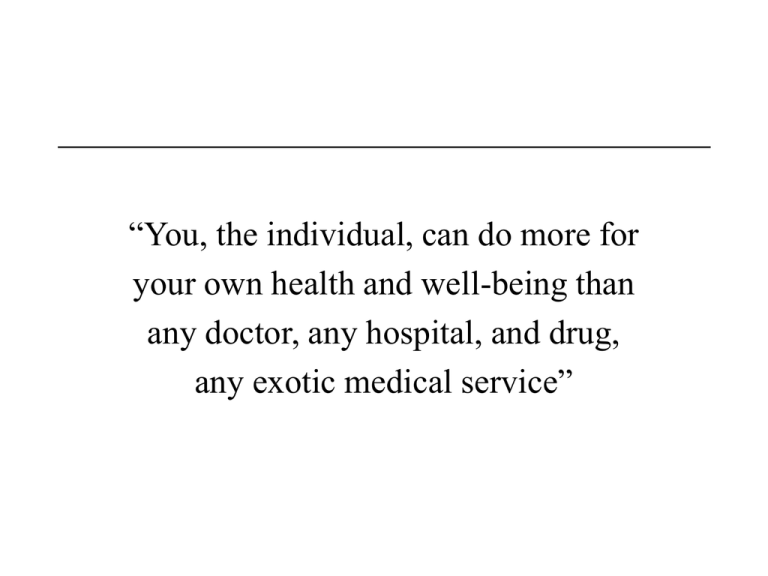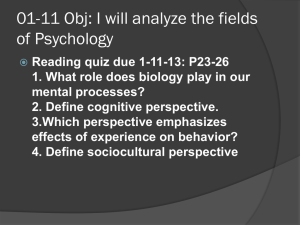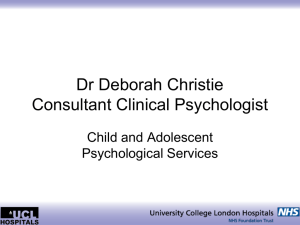Health_L1_handout - University of Toronto Mississauga
advertisement

“You, the individual, can do more for your own health and well-being than any doctor, any hospital, and drug, any exotic medical service” US Department of Health, Education, and Welfare Health Psychology University of Toronto Winter, 2005 Dr. Duane Hargreaves Email: dhargrea@utm.utoronto.ca Phone: (905) 828-3957 Web: www.utm.utoronto.ca/~w3psy333/winter2005.htm Lecture 1 - Outline • Part 1 – Welcome and Introduction – Topic Overview - Aims and Objectives – Assessment • Part 2 – What is Health Psychology? • Part 3 – Scientist-Practitioner Model Lecture 1 - Part 1 Welcome and Introduction Course Handbook Course Instructors Learning Outcomes Course Outline (readings) General information (expectations, contact, assessment, text) Lecture Outlines Lecture 1 - Part 2 What is Health Psychology? Question What is most important in our lives? Freedom Enjoying life Honesty Reciprocation of favors Social power Broadminded Successful True friendship Healthy Accepting my portion in life Self indulgent Protecting the environment Social order Responsible Social Justice Pleasure Equality Self-respect A varied life Wealth A spiritual life Respect for tradition Family security Curiosity Wisdom Loyal Question What is most important in our lives? Sample of 162 women and men • Most important … • 2nd most important … • 3rd most important … • 4th most important … • Etc … What is Health? Health is popularly defined in terms of absence of disease, but may be viewed as an illness/wellness continuum The World Health Organization (WHO) defines health as “a complete state of physical, mental and social well-being and not merely the absence of disease or infirmity”. Illness/Wellness Continuum 1900 1990 Changing patterns of illness Summary • 1900s - infectious diseases main cause of death (acute conditions) • 1960s - degenerative diseases main cause of death (chronic conditions) • 1990s - new infectious disease main cause of premature death (chronic condition) Death rates from infectious and parasitic disease, 1907 to 1998 Acute vs. Chronic Disorders Summary • acute conditions = short-lived, curable – Etiology - Beyond individual control • chronic conditions = long-lasting, no cure – Etiology - Partly influenced by behavior Reasons for changed causes of death • Improved hygiene (water supply, etc) • Penicillin (antibiotics) • Aging population (risk factor for degenerative disease) • Health Behaviors – Activities to prevent or detect disease Change 5 behaviors According to the US Public Health Service, of the 10 leading causes of death in the US, at least 7 could be reduced substantially if people at risk would change just 5 behaviors! 1. Adherence to medical recommendations (eg use of hypertensive medication) 2. Diet 3. Smoking 4. Lack of exercise 5. Alcohol and drug use Estimated contributions of behavior, medical care, genetics, and other factors to health status. Behavior 40% Models of Health • Biomedical Model – Historically, dominant paradigm – Suggests illness is a function of aberrant somatic processes – Main Focus = cure (biology and medicine) Models of Health • Biopsychosocial Model – Current dominant paradigm – All conditions of health and disease have mental and social components – Main focus = health (prevention not cure) Models of Health • Biopsychosocial Model “health (wellness and illness) is a function of biological, psychological, and social factors in continual interaction” A “factors” approach A “systems” approach The Biopsychosocial Model from Factors and Systems Perspectives Health Psychology • What is health psychology? “the aggregate of the specific educational, scientific, and professional contributions of the discipline of psychology to … – Promotion and maintenance of health (health habits) – Prevention and treatment of illness (clinical) – Identification of etiological and diagnostic correlates of health and illness (research) – Analysis of the health care system and health policy formation (political) (Matazarro, 1982) Health Psychology … vs. other health-related disciplines • Medical psychology • Psychosomatic medicine • Behavioral medicine • Behavioral health • Medical sociology Publications in Health Psyc. Lecture 1 - Part 3 Scientist-Practitioner Model Scientist-Practitioner Model The essence of the S-P model is that students in clinical psychology should be trained in research as well as clinical skills. Implications of the S-P model for clinical practice are a little less clear! S-P model in practice 3 different emphases: • Practitioner uses research and basic principles to guide treatment and assessment or to develop new approaches (evidenced-based) • Practitioner evaluates outcome (formal assessment of outcome) • Practitioner engages in research Practitioners engage in 1, 2, or all 3 emphases Importance of Psych. Theory • Basis for effective techniques lies in the theoretical substrate of the discipline of psychology • Development of new therapies/interventions depends upon this theoretical basis • Application to complex or new problems requires a theoretical basis – Eg Walby (1970) … systematic desensitization for phobias previously thought untreatable. • Causal processes and mechanisms of change Importance of Empiricism • Evaluation of the efficacy of treatments • Empirical justification for claims • Delineation of limits of claims (rarely unequivocal) – Success rates, breadth of response, long-term outcome • Study of predictors of outcome • Best practice protocols Scientist-Practitioner Model Hierarchical Knowledge Stores • Empirically established relationships • Scientific theories • Clinical lore (shared beliefs and practices) • Professional experience • Personal experience (James, 1991) … acknowledges that we don’t know everything! Scientist-Practitioner Model Brief History… • University clinics (foundation for US model of training) – – – – 1896 Pennsylvania Clinic 1908 Colorado 1909 Minnesota 1914 (26 University clinics in USA) • Boulder Conference (1949) – Research and clinical practice as joint training goal • B F Skinner (1953) … Science and Human Behavior • Hans Eysenck (1959) … Learning Theory and Behavior Therapy • 1960s and 70s … treatment outcome evaluations Scientist-Practitioner Model Brief History… • 1980s and 1990s – – – – – – – – Large scale studies and follow-ups Extensions to new areas Refinement of techniques (eg anxiety disorders) Relapse prevention (eg addictions) Growth of behavioral medicine and health psychology Use of the term “cognitive-behavior therapy” Cost-effectiveness Manual-based treatments derived from research Scientist-Practitioner Model Manual-Based Treatments • Development of manuals as a “revolution” • Evidence-based medicine • Advantages – – – – Consistency of application (replicability) Quality assurance for customers Ease of training Division 12 (APA task force) • Criticisms – Appropriate renewal Scientist-Practitioner Model Scientific Achievements • • • • • Most effective treatment for anxiety Very effective treatment for depression Sexual problems Eating disorders, addictions Health psychology – – – – Pain Diabetes Cardiovascular disorders Tinnitus Scientist-Practitioner Model Professional Achievements • Role of psychologist strengthened as providers of effective interventions • Empirical justification for psychological therapy - potential cost effectiveness • More effective therapy for clients for a wide range of problems - extension to health • Link between pure and applied psychology Scientist-Practitioner Model Implications for Health Psychology • Adherence to the S-P model • Active involvement of psychologists is transfer of psychological knowledge to other health care professionals – Nurses, doctors, pharmacists, OTs, speech therapists, physiotherapists, etc – Psychologizing of health care • “The promulgation of the scientific ethos in general, and the S-P model in particular, among all the health professions.” (James, 1991) Scientist-Practitioner Model Invalid Criticisms • Few clinicians engage in research • Treatment-outcome literature is not useful • What does the clinician do when a client fails to respond • Clinicians need to be pragmatic, flexible, eclectic • “human problems cannot be solved by science - therapy is an art, not a science” – Limited view of science








